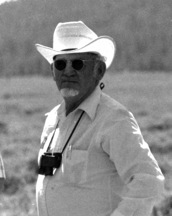

|

|
IN MEMORIAM
Harold F. Heady
Professor of Forestry (Range Management), Emeritus
UC Berkeley
1916 – 2011
Harold Heady was born in Buhl, Idaho, March 29, 1916, and died after a short illness in Le Grande, Oregon, on April 28, 2011. He grew up on Snake River Plain farms and ranches, putting himself through high school after the early death of his parents. After graduating from the University of Idaho with a BS in 1938 he moved east to pursue an MS awarded in 1940 by the New York State College of Forestry. During World War II, except for a very brief stint in the Navy, he taught range management at Montana State University. While holding faculty positions at MSU and later at Texas A&M he simultaneously earned a Ph.D. at the University of Nebraska working under the eminent prairie ecologist John Weaver, and helped found the American Society for Range Management (ASRM), serving as its first Secretary–Treasurer in 1948. Much later he was president of what had become an international SRM of 5,000 members and has since received all of its major awards.
In 1951 Harold made a potentially risky decision to vacate a tenured position at Texas A&M accepting a position in UC Berkeley’s School of Forestry as Assistant Professor, joining two other former Weaver students (Harold Biswell and Arnold Schultz) on the faculty. When Harold arrived at Berkeley in 1951 the University had just purchased the Hopland Field Station and was also expanding range management on the Davis campus. This led to many productive research collaborations and years of joint teaching on both the Berkeley and Davis campuses. The Interdepartmental Graduate Group in Range Management at Berkeley was established in 1965 and chaired by Harold until 1975. He mentored many successful graduates from Range Management, Forestry, and Botany programs, a group including department chairs, deans, and university presidents, among them the first women to hold these positions.
Harold’s research at Berkeley focused on the ecology and management of the California grassland and quickly earned him tenure. He was appointed at Berkeley mainly to bring a highly quantitative approach to the program, but as is too rare today, he was also a broadly trained botanist and field scientist. Several of his research papers are landmarks of organized critical thinking that stand out in the often highly applied and stubbornly traditional field of range management. One of the continuing tasks of current grassland scientists is to remind students to ‘‘. . . read what Heady wrote about this in . . .’’. His papers cover such ground as the height/weight relationships of grasses, still relevant to current problems with grazing utilization standards; specialized grazing systems, an area of ongoing debate over his ideas; vegetation sampling and analytical methods; causes of inter- and intra-annual variation in species composition; ways to study and understand dietary selection in grazing animals; and livestock/wildlife interactions, of which the latter has become much more important in modern range management.
Two projects illustrate Harold’s approach to research. He followed the complex ecosystem effects of a woodland type conversion at Hopland for 19 years. The work involved a complex experimental design that could not have been analyzed without the invention of modern computer-based methods during the course of the study. Most of us involved with the study believe that Harold must have known all along that this would happen. A second study established a series of plots over a 300-mile transect to examine the effects of natural mulch on productivity and composition of grassland. Data from this robust study are still being analyzed today and form the basis for what is now the most important technique for monitoring livestock grazing intensity on annual rangelands.
For much of his career Harold was a major player in international resource management. He loved foreign travel, usually to remote locations, and spent sabbaticals (with Guggenheim and Fulbright support) in Kenya, Saudi Arabia, and Australia. While in Kenya he turned an enforced stay in the hospital and a ban on riding in Land Rovers into his landmark 1958 monograph Range Management in East Africa. Harold was the chairman of the ongoing International Rangeland Congress from its inception in 1974-1977. His 1975 textbook Rangeland Management has been widely used and has seen three editions. He and his wife Eleanor co-authored another textbook Range and Wildlife Management in the Tropics in 1982. Harold’s other synthetic works include several book chapters on the California grassland and two in-depth analyses of the Vale range improvement project in eastern Oregon.
In 1974 Harold took on more administrative jobs, serving as Associate Dean of the new College of Natural Resources at Berkeley from 1974 to 1977. In 1977 he assumed the UC system-wide post of Assistant Vice-President for Agriculture and University Services. He returned to full-time teaching and research in 1980. Harold was awarded the Berkeley Citation in 1991 for extraordinary contributions to the university and his field of work.
Following his formal retirement from UC in 1983 Harold continued to travel extensively in central Asia, Latin America, and Australia, collaborate on research, and write books and articles. An avid conservationist and outdoorsman, he moved from Berkeley to Le Grande, Oregon in 2005, where he continued fishing and hunting well into his 90s. He was preceded in death by wife Eleanor (Butler) in 1979 and 2nd wife Ruth (Atkinson) in 2001. He is survived by his daughter and son; plus 3 grandchildren and 4 great-grandchildren.
James W. Bartolome
Lynn Huntsinger
2012